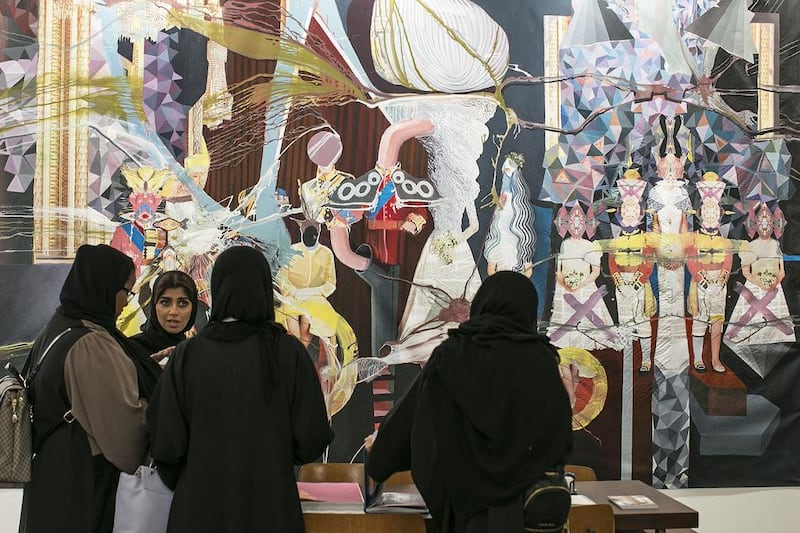The 11th edition of Art Dubai closed yesterday and it was, according to its director Myrna Ayad, another success. “We had very positive feedback from galleries, artists and visitors and it was an exciting first edition for me,” she says. “I’m already looking forward to next year’s edition as well as to develop and grow the fair alongside the team.”
Other than Ayad herself, who is new to the post this year, there were several other changes made to the team and the programmes that contributed to its success.
In the largest two halls, which housed the contemporary galleries, independent curators Sam Bardaouil and Till Fellrath acted as guest curators, and the result was a smooth flowing of the galleries and artworks.
It was easy to traverse the halls without feeling overwhelmed by the sheer number of artworks, and there were some really interesting juxtapositions of artworks in adjacent booths that somehow added to the appreciation of each piece.
For example, Gallery Isabelle Van Den Eynde was showing some small works on paper by Emirati artist Mohammed Kazem and French artist Abdelkader Benchamma.
Benchamma’s works were delicate ink markings and Kazem’s were made by letting paint run down the paper – the overall calm feeling of both sets of works was mirrored in the paintings in the next booth where Sirak Melkonian, an Iranian artist who made similarly meditative lines across his canvases, was showing with Ab-Anbar Gallery from Tehran.
At Upstream Gallery from Amsterdam, the work of Rafaël Rozendaal, a Dutch-Brazilian artist who uses the lenticular technique to produce work that is somewhere between a computer screen and a traditional painting, was echoed across the hall in Galerie Daniel Templon, who were displaying lenticular photographs by leading Indian artist Jitish Kallat.
Dubai's own Green Art Gallery showed a painting by Kamrooz Aram, who uses a form of geometric abstraction. His use of pattern was nicely reflected in a photograph on display in Athr Gallery over the corridor taken from Saudi artist Ahmed Mater's Desert of Pharan – an ongoing project that documents the rapid development of Mecca.
It was an aerial image of the Al Mansur district of Mecca, whose small and tightly packed houses seemed to mirror the pattern in the painting.
These similarities of shape, form and mood were found throughout the contemporary halls, and allowed for an easy transition for the visitor as they passed through galleries that had come from all over the world.
The breadth of nations and influences was commendable, too. There was art from emerging Russian artists at Moscow’s Pechersky Gallery, fantastic marble sculptures from Uruguayan gallery Piero Atchugarry and controversial paintings from Ramallah’s Zawyeh gallery.
Some of the more established galleries, however, did not seem to make an effort to bring audiences new artworks.
Galleria Continua had a similar presentation as that of last year, seemingly relying on star names such as Anish Kapoor and Michelangelo Pistoletto to garner interest.
Waddington Custot Gallery, which is from London with its co-founder Stephane Custot having an eponymous space in Dubai, were showing Marc Quinn's painting The Eye of History (Atlantic Perspective) Points of Continent, which although it resembles the work from the same name that the gallery showed in their exhibition is actually a new work from Quinn's series.
The third hall of galleries, dedicated to modern artwork (from the 1940s to 1980s), was impeccable.
It is a much smaller area with only 15 galleries and was filled with artworks that revealed the history of the region. ArtTalks, from Egypt, featured stunning works by Mamdouh Ammar, whose paintings about war were haunting.
DAG Modern, from India, had some truly beautiful work by Biren De and GR Santosh, artists from the neo-tantric movement.
The inaugural Modern Symposium was Ayad’s most notable contribution to the fair’s roster of events.
A robust programme of discussions ranging from the role of women in modern art to the similar artistic influences in North Africa and South Asia, it was an effort to contribute to the art education of the region and was a successful first edition.
There were so many interesting talks this year at this symposium – the Global Art Forum and the talks within the fair’s regular programming.
However, for those who missed them, the Global Art Forum talks will be published online.
aseaman@thenational.ae





